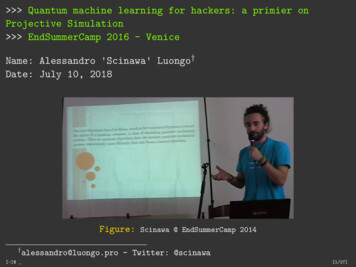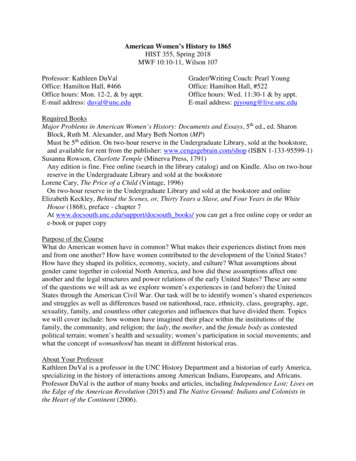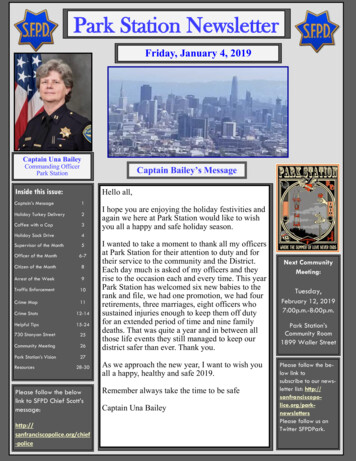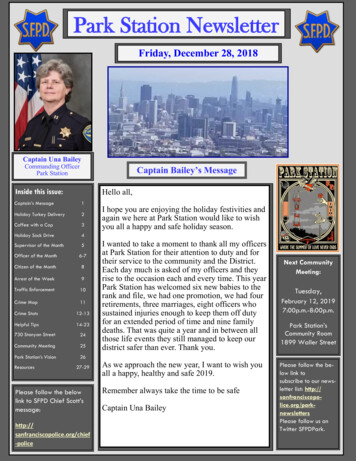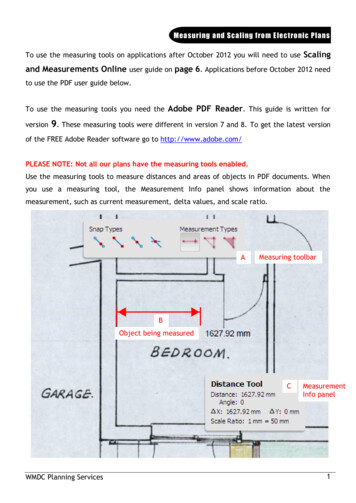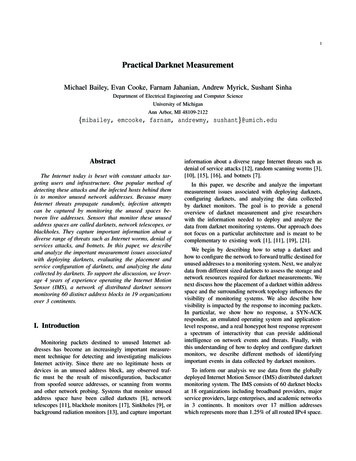
Transcription
1Practical Darknet MeasurementMichael Bailey, Evan Cooke, Farnam Jahanian, Andrew Myrick, Sushant SinhaDepartment of Electrical Engineering and Computer ScienceUniversity of MichiganAnn Arbor, MI 48109-2122{mibailey, emcooke, farnam, andrewmy, sushant}@umich.eduAbstractThe Internet today is beset with constant attacks targeting users and infrastructure. One popular method ofdetecting these attacks and the infected hosts behind themis to monitor unused network addresses. Because manyInternet threats propagate randomly, infection attemptscan be captured by monitoring the unused spaces between live addresses. Sensors that monitor these unusedaddress spaces are called darknets, network telescopes, orblackholes. They capture important information about adiverse range of threats such as Internet worms, denial ofservices attacks, and botnets. In this paper, we describeand analyze the important measurement issues associatedwith deploying darknets, evaluating the placement andservice configuration of darknets, and analyzing the datacollected by darknets. To support the discussion, we leverage 4 years of experience operating the Internet MotionSensor (IMS), a network of distributed darknet sensorsmonitoring 60 distinct address blocks in 19 organizationsover 3 continents.I. IntroductionMonitoring packets destined to unused Internet addresses has become an increasingly important measurement technique for detecting and investigating maliciousInternet activity. Since there are no legitimate hosts ordevices in an unused address block, any observed traffic must be the result of misconfiguration, backscatterfrom spoofed source addresses, or scanning from wormsand other network probing. Systems that monitor unusedaddress space have been called darknets [8], networktelescopes [11], blackhole monitors [17], Sinkholes [9], orbackground radiation monitors [13], and capture importantinformation about a diverse range Internet threats such asdenial of service attacks [12], random scanning worms [3],[10], [15], [16], and botnets [7].In this paper, we describe and analyze the importantmeasurement issues associated with deploying darknets,configuring darknets, and analyzing the data collectedby darknet monitors. The goal is to provide a generaloverview of darknet measurement and give researcherswith the information needed to deploy and analyze thedata from darknet monitoring systems. Our approach doesnot focus on a particular architecture and is meant to becomplementary to existing work [1], [11], [19], [21].We begin by describing how to setup a darknet andhow to configure the network to forward traffic destined forunused addresses to a monitoring system. Next, we analyzedata from different sized darknets to assess the storage andnetwork resources required for darknet measurements. Wenext discuss how the placement of a darknet within addressspace and the surrounding network topology influences thevisibility of monitoring systems. We also describe howvisibility is impacted by the response to incoming packets.In particular, we show how no response, a SYN-ACKresponder, an emulated operating system and applicationlevel response, and a real honeypot host response representa spectrum of interactivity that can provide additionalintelligence on network events and threats. Finally, withthis understanding of how to deploy and configure darknetmonitors, we describe different methods of identifyingimportant events in data collected by darknet monitors.To inform our analysis we use data from the globallydeployed Internet Motion Sensor (IMS) distributed darknetmonitoring system. The IMS consists of 60 darknet blocksat 18 organizations including broadband providers, majorservice providers, large enterprises, and academic networksin 3 continents. It monitors over 17 million addresseswhich represents more than 1.25% of all routed IPv4 space.
ePCMultiSwitchAdapterCardDeviceNetFlowrouterPC oute S15500 Optical Ampliifer Optical ServicesPC anagementTransportRouterCardrporate IconographyrSi8 0 2. 11NetRangerNetSonarNetworkOpticalOptical Multi-FabricAmpliifer oH rAccessAccess IP (Music on o ProductsPC tchVPNRouter withGatewayFirewallVPNconcentratorInternetSiRouter Router withrouterSilicon SwitchWirelessRouterBridgeRepeaterIP1:interface FastEthernet2/0Service controlSIP ProxySmallip address 31.0.0.1server 255.255.255.252hub3:arp 31.0.0.2 0009.6b49.f013 ARPA4:ip route 31.1.1.0 255.255.255.0 31.0.0.25:ip route 31.0.0.0 255.0.0.0 31.0.0.2IP6:ip route 192.168.0.0 255.255.255.0 31.0.0.2ServerService controlSIP ProxySmall7:ip ub8:ip route 10.0.0.0 255.0.0.0 31.0.0.2Server withPC r with Router withRouterSecurityServer with31.2.0.0/16SoftswitchRouter withStorage Router StorageStandardSecurityServer withPGWSilicon Switcharrayhost Firewallappliance STPPC RouterRouterSilicon SwitchappliancePC RouterMGCSiWiSMWLAN controllerWorkgroupdirectorDarkNet2Route SwitchProcessorSimple DarkNet Network lDatabaseSTPServerSwitchService mTape G seriesUnity serverUniversalGatewayVIPFig. 1. A sample configuration which illustrates the three major darknet deployment models;capturing traffic out-bound to reserved space (lines 6-8), traffic destined to a statically configured,unusedsubnet (line 4), or capturing all unused space withinSTPan allocation. (line PGWDarknetDeploymentarrayMGCVirtualLayer SwitchII.Tape arrayVirtualswitch controller(VSC 3000)TDMrouterTranspathuBR910StorageRouteruMG seriesUnity serverUniversalGatewayVIPSTPsimilar to adding a route to prevent flooding attacks againstpersistent loops [20].The setup thus far has assumed monitoring of unusedThe deployment of a darknet monitoring system readdressesthat are both globally addressable and reachable.quires an understanding of the topology of the localTDMItisalsopossible to monitor unused and non-routablenetwork. Since a darknet monitor observes traffic to unusedaddresses[5].For example, RFC1918 addresses areoftenthe upstreamdynamic host configuSystem addresses,TranspathuBR910uMG seriesUnity serverTapearray router or lcontrollerration server must be instructed torouterforward scanalsopackets to the monitor. In this section we highlight rof the important challenges associated with configuringconfiguration in Figure 1 demonstrate how to setup staticthe network and then discuss how to provision adequatefall-through routes for the three major RFC 1918 ranges.storage and network resources for a darknet system.VirtualLayer SwitchVirtualswitch controller(VSC 3000)A. ConfigurationVirtualVirtualThere are threegeneral techniques for forwarding packLayer Switchswitchcontrollersystem. The simplest approachets to a darknet monitoring(VSCthe3000)is to configuremonitoring box to send ARP repliesfor each unused address to the router. This works wellwhen the darknet is well-defined and spans a few addressesor when access to the upstream router is not possible.However, it is far less efficient with thousands or millionsof monitored addresses. A more scalable approach is toconfigure the upstream router to statically route an entireaddress block to the monitor. This idea is illustrated inline 4 of the router configuration in Figure 1. This figuredepicts a darknet monitoring setup in which the monitoris connected to a switch which is then connected to anupstream router. The use of a static route illustrated in thefigure is simple but requires that darknet address blockbe specifically set aside for monitoring. A more flexibleapproach is to route all packets destined to locations thatdo not have a more specific address configured (and wouldthus be dropped) to the monitoring system by means of ablackhole (also called a fall-through route). Thus, if anorganization is allocated a /8, then it could create a staticroute to the darknet monitor for the entire /8. Packets tovalid addresses will hit more specific prefixes and onlypackets to unused addresses will fall through to the /8route. This idea is also illustrated in Figure 1 and isB. Resource ProvisioningUnderstanding the storage and network requirements ofa darknet is critical to correctly provision the monitoringsystem as the amount of incoming traffic can be quitelarge. These requirements are typically dependent on thenumber of addresses monitored. To provide a generaloverview of the data rates observed at darknets of differentsizes, we measured the packets per day per IP for varioussized darknet blocks. The results are shown on the leftof Figure 2. Note that the darknets that monitored lessaddresses tended to receive more packets per day per IPthan the larger darknets. We explore these differences inmore detail in the next section. On average, we found thata small /24 sensor is likely to see a sustained rate of 9packets per second, a moderately sized /16 monitor will seeroughly 75 packets per second, and a large /8 monitor over5,000 packets per second. An important caveat that biasesthese results is that the /24 monitors actively responded tocertain incoming connections. We found that the trafficwas between 1.1 to 16 times greater on average thannearby passive /24 monitor. Details on the response aredescribed in the next section. Another consideration is thatthe average rates can be deceptive because traffic routinelybursts two to three orders of magnitude above the sustainedrate. For example, one IMS sensor has had a sustained rateof 9 packets per seconds over the last 2.5 years witha daily low of .6 packets per second and a daily highUG
3Number of Packets per Day per IP100001000100101001000100001000001000000Number of IPs in the DarkNet10000000100000000Fig. 2. The provisioning requirements for various blocks. On the left the number of packets seen perday per IP for various sized blocks. On the right the size on disk for various representations of ofdarknet TrafficIII. Darknet Visibility ConsiderationsBefore deciding exactly what addresses to allocate to adarknet it is important to understand how the placementof a darknet impacts what it observes. It has been shownthat the malicious and misconfigured activity observed bytwo different but equally sized darknets is almost neverthe same [6]. These differences tend to depend on two100000Packets per day per IPof 290 packets per second. The average packet size wasapproximately 100 bytes. The corresponding bandwidthrequirements for an average /24 sensor is 7 Kbps, 60 Kbpsfor a /16 monitor, and 4 Mbps for a /8 monitor.The storage format used to log incoming packets alsohas a large impact on the storage requirements. Common formats for collecting network traces like pcap andNetFlow are well suited for collecting darknet data. Tobetter quantify the actual storage requirements based ondifferent darknet sizes, we analyzed the bytes required fordifferent storage formats (in raw and zipped format) at/16 darknet monitor over a 17 hour period. The results areshown by hour on the right side of Figure 2. The plot showsthat pcap tends to compress very well and so keeping datafiles in gzip format can reduce storage requirements bymore than a factor of two. The figure also shows thatwhile flow-based representation lose important data likea the payload, they do provide excellent data reduction.There was nearly 15:1 compression when converting pcapto Netflow v9.These measurements demonstrate that a /16 monitorcan record a few months worth of data on commodityhardware with a single disk. Furthermore, by compressingor converting data into flow-based formats the storagerequirements can be reduced by a factor 2 to 15.100001000100100246810 12 14 16 18 20 22 24SensorsFig. 3. Packet per day per IP at 25 differentIMS darknet monitors.important factors: the placement of a darknet, and the wayin which a darknet responds to incoming packets. In thissection we provide a brief overview of these two influencesand describe how they impact darknet visibility.A. PlacementEvaluating the placement of a darknet involves understanding several topological factors. One of the biggestinfluences on visibility appears to be vicinity to live hosts.That is, proximity in IP address space to live hosts [6].Figure 3 shows the average packets per day per IP for 25of the IMS sensor blocks. The values are normalized perIP to make different sized blocks comparable. The valuesrange from 10 packets per day to more than 10,000 packetsper day per IP. Of note, the darknets that observe the most
4Increasing -ACKNo ServiceEmulationPassiveLocal ScopeBreadthIncreasing CostLive HostDistributedGlobal ScopeFig. 4. Illustration of the tradeoffs betweenthe number of addresses a darknet can monitor (breath) and the accuracy of the responses from a darknet as compared to a realhost (depth). Additional resource costs areincurred attempting improve breath or depth.traffic also tend to be smaller ( /24) and are located in livenetworks near hosts.The concrete reasons behind these traffic differences arestill not well understood but it appears to be related to targeting behavior [6]. In particular, the preference for nearbyaddresses by malware and misconfigured applications. Forexample, Internet worms like Blaster [3] and Nimda [4]have a strong preference for nearby addresses. Anotherfactor appears to be targeting by botnets and other attackers [7]. By targeting specific ranges of addresses that areknown to contain vulnerable hosts, attackers can increasethe number of systems they are able to compromise.Another important darknet placement consideration isthe location within a network. If a darknet monitor isplaced behind a firewall or other infrastucture protection orfiltering device, it will likely not observe externally sourcedthreats. On the other hand, darknets within the network canalso provide important visibility into locally-scoped threatswithin a network. Ideally, a darknet deployment that includes monitors deployed both inside and outside networkperimeters should have the greatest potential visibility.B. Service configurationThe visibility provided by darknets is also heavilydependent on how a darknet responds to incoming packets.The simplest action is not to respond at all. A passively configured darknet simply records all the packetsit observes and no further action is taken. This revealsthe address of the host sending the packet and otherheader information. However, it may not reveal criticaldata like the exploit used in an attack or the detailsof misconfigured application requests. For example, allvalid TCP transactions require a three-way handshake thatmust be completed before any application-level data isexchanged. This means that a passive darknet will notobserve application-level data from hosts that attempt toconnect via TCP.An active response to incoming packets on a darknetcan be used to collect additional application-level information to better understand an exploit attempt and betterunderstand the intentions of an attacker. A simple buteffective active response technique is to respond to TCPSYN packet with TCP SYN-ACK packets [1]. A singlestateless response packet provides at least the first datapacket on a TCP session and helps uniquely identifycomplex threats like the Blaster worm.The first data payload may not provide enough information, so more complex responses can be used to elicitadditional information. One method of generating theseresponses is to emulate the behavior of a real host [14],[21]. An emulated host can masquerade as a large varietyof operating system and application combinations. Anemulator provides the flexibility to emulate just enough ofan application to acquire the needed information. However,one danger is that a malicious attacker could identity anemulated host and avoid a darknet monitor or sent it falseinformation. The simple way to reduce the impact of thisfingerprinting problem is to use a real host (i.e. a honeypot)instead of an emulated host [18].A real host can provide complex information on anattacker and help profile the behavior, however, it can bevery resource intensive. The cost of running a real hostis significant and limits the number of possible monitoredaddresses from thousands to just a handful. One way toregain scalability is to use a pool of quickly recyclablevirtual machines [19] so that multiple virtual hosts can beexecuted on a single physical system. Another method isto filter the connections before they reach the end hosts sothat only the newer and more interesting connection areinvestigated [2].Together, these different response techniques form aspectrum of interactivity that provide additional information from darknets. Figure 4 visually depicts this spectrumalong the y-axis labeled depth. We define depth as ameasure of the accuracy of the responses from a darknetwhen compared to the responses from a real host. On the xaxis is breadth. We define breadth as a measure of scope ornumber of addresses a darknet monitor can observe. Thisfigure demonstrates the tradeoffs between scalability andfidelity and associated resource cost incurred in attemptingto achieve additional breadth or depth.A final and critical configuration decision when runninga darknet with real or emulated hosts is what operating
IMS Darknet ReportsReport from 24 hours of darknet traffic from enterprise networkNetwork/MaskType ABLE I. Different TCP implementations andHTTP server configurations across differentproduction networks.systems and applications should be run/emulated. Thisis a very important consideration because it can be thedifference between quickly identifying a new threat ormissing it because the correct service was not running.Choosing appropriate services to run is far more complexthan it might first appear. We conducted a survey of the services running on the University of Michigan’s engineeringcampus and found a wide variety of operating system andapplication combination. A table of the different TCP stackand HTTP server implementations is shown in Table IIIB. In the table, network A/16 contained 5512 scannablehosts and we found 252 unique TCP implementations,241 unique HTTP configurations, and 1210 combinationsof TCP and open and closed port configurations. Thisdiversity means that choosing the right services to run isa complex problem for which their is currently no simplesolution.IV. Analysis of Darknet DataDarknets can produce vast quantities of highdimensional measurement data. Making sense of this datacan be a daunting task. An entire study was dedicatedto understanding the traffic observed in darknets [13]. Ingeneral, darknet traffic can be classified into four mainareas: Infection attempts by worm, botnet, and exploit tools. Misconfigured application requests and responses(e.g. DNS). Backscatter from spoofed denial of service attacks. Network scanning and probing.Generating these classifications can be complex due toscalability constraints from the huge amount of darknetdata that must be processed. One method of reducingthis effort is to filter the data into a smaller set of moremanageable events. One simple yet powerful method isto cluster the data by source address [13], [2]. A singleaddress may contact many different destination addresses5All SourcesTotal IP Packets:57178687Total TCP Packets: 20173121Total UDP Packets: 34238463Total ICMP Packets: 2747341Unique Source IPs: 95888Statistics on Top 10 TCP Source IPs:Source IPTCP Pkt Cnt Top 3 Dest PortsX.X.56.81229695tcp/445:221043 tcp/8080:8652X.X.153.156 219602tcp/445:219593 tcp/80:9X.X.199.134 162931tcp/443:26456 tcp/80:25899 tcp/1315:1113Statistics on Top 10 UDP Source IPs:Source IPUDP Pkt Cnt Top 3 Dest PortsX.X.29.611272378udp/53:1272202 3518udp/137:238843 udp/123:3251 udp/138:1416Statistics on Top 10 ICMP Source IPs:Source IPICMP Pkt Cnt Top 3 Dest mp/8:175178X.X.14.23152564icmp/8:152564- 56 -Fig. 5. Example of an IMS report based onclustering by source address.in the darknet but will tend to perform similar behavior ateach address. For example, a host infected with the Slammer worm [10] may scan tens or hundreds of thousandsof destination addresses in a single day. This generates ahuge amount of total traffic however it can be compresseddown to a single event by grouping all that traffic by thesingle Slammer source address. To get a better idea ofthe real-world savings consider that a certain IMS darknetreceived 57,178,687 IP packets in a single 24-hour period.If we instead cluster that same traffic by source address wefind 95,888 unique source IPs. Thus, this simple techniqueprovides three orders-of-magnitude savings in the numberof events that must be analyzed. We leverage this techniqueto provide daily IMS reports to operators of potentiallyinfected systems. A clipping from a report detail the same24-hour period described earlier is shown in Figure 5.A. Global and Local Darknet EventsThe individual events detected in darknets can usuallybe further divide to two locality classes. When an eventsuch a new attack or large increase in probing occurs, itwill impact a very small number of addresses (i.e., local)or the entire Internet (i.e., global). This classification onlyapplies to the destination of an event so a local event couldoriginate from a different network across the Internet aslong it targeted a specific destination network. Figure 6shows examples of global and local events. The left paneof the figure shows a globally-scoped attack against theMySQL service as observed by 23 IMS sensors (eachcolor represent a separate sensor). In the right pane is atargeted RPC-DCOM attack observed in academic networkcontaining an IMS sensor. In general, we see this bimodaldistribution across many different vectors such as payloadand source addresses. The implication is that attacks andother events observed in darknets are observed at only onenetwork or are widespread and are observed at many pointsaround the Internet.V. ConclusionThis paper has described the important measurementissues associated with deploying darknets, configuringdarknets, and analyzing the data collected by darknet
Unique source IPs contacting TCP port 3306 over 9 daysUnique source IPs contacting TCP port 135 over 3 days23 unique IMS address blocks at 14 sites normalized by /2423 unique IMS address blocks at 14 sites normalized by /24660Unique Source IPs / 1 hourUnique Source IPs Per 04-200502-05-2005Fig. 6. The left figure is globally-scoped attack against the MySQL service as observed by 23 IMSsensors (each color represent a separate sensor). In the right figure is a targeted RPC-DCOM attackobserved in academic network containing an IMS sensor.monitors. We have attempted to provide researchers with ageneral overview of darknet measurement and the important details needed to deploy darknet monitoring systems.This analysis has attempted to demonstrate that buildingand operating a darknet monitor is a simple and productivemethod of gaining significant additional visibility intonetwork threats and the state of local network and Internetas a whole.AcknowledgmentsThis work was supported by the Department ofHomeland Security (DHS) under contract numberNBCHC040146, and by corporate gifts from Intel Corporation and Cisco Corporation. The authors would like tothank all of the IMS participants for their help and suggestions. We would also like to thank Danny McPherson, JoseNazario, Dug Song, Robert Stone, and G. Robert Malanof Arbor Networks and Manish Karir and Bert Rossi ofMerit Network for their assistance and support.References[1] Michael Bailey, Evan Cooke, Farnam Jahanian, Jose Nazario, andDavid Watson. The Internet Motion Sensor: A distributed blackholemonitoring system. In Proceedings of Network and DistributedSystem Security Symposium (NDSS ’05), San Diego, CA, February2005.[2] Michael Bailey, Evan Cooke, Farnam Jahanian, Niels Provos, KarlRosaen, and David Watson. Data Reduction for the ScalableAutomated Analysis of Distributed Darknet Traffic. Proceedingsof the USENIX/ACM Internet Measurement Conference, October2005.[3] Michael Bailey, Evan Cooke, David Watson, Farnam Jahanian, andJose Nazario. The Blaster Worm: Then and Now. IEEE Security& Privacy, 3(4):26–31, 2005.[4] CERT Coordination Center. CERT Advisory CA-2001-26 NimdaWorm. 2001.[5] Evan Cooke, Michael Bailey, Farnam Jahanian, and RichardMortier. The dark oracle: Perspective-aware unused and unreachableaddress discovery. In Proceedings of the 3rd USENIX Symposiumon Networked Systems Design and Implementation (NSDI ’06), May2006.[6] Evan Cooke, Michael Bailey, Z. Morley Mao, David Watson,and Farnam Jahanian. Toward understanding distributed blackholeplacement. In Proceedings of the 2004 ACM Workshop on RapidMalcode (WORM-04), New York, Oct 2004. ACM Press.[7] Evan Cooke, Farnam Jahanian, and Danny McPherson. The Zombieroundup: Understanding, detecting, and disrupting botnets. InProceedings of the Steps to Reducing Unwanted Traffic on theInternet (SRUTI 2005 Workshop), Cambridge, MA, July 2005.[8] Team Cymru. The darknet project. http://www.cymru.com/Darknet/index.html, June 2004.[9] Barry Raveendran Greene and Danny McPherson. Sinkholes: Aswiss army knife isp security tool. http://www.arbor.net/, June2003.[10] David Moore, Vern Paxson, Stefan Savage, Colleen Shannon, StuartStaniford, and Nicholas Weaver. Inside the Slammer worm. IEEESecurity & Privacy, 1(4):33–39, 2003.[11] David Moore, Colleen Shannon, Geoffrey M. Voelker, and StefanSavage. Network telescopes. Technical Report CS2004-0795, UCSan Diego, July 2004.[12] David Moore, Geoffrey M. Voelker, and Stefan Savage. InferringInternet denial-of-service activity. In Proceedings of the TenthUSENIX Security Symposium, pages 9–22, Washington, D.C., August 2001.[13] Ruoming Pang, Vinod Yegneswaran, Paul Barford, Vern Paxson,and Larry Peterson. Characteristics of Internet background radiation. In Proceedings of the 4th ACM SIGCOMM conference onInternet measurement, pages 27–40. ACM Press, 2004.[14] Niels Provos. A Virtual Honeypot Framework. In Proceedings ofthe 13th USENIX Security Symposium, pages 1–14, San Diego, CA,USA, August 2004.[15] Colleen Shannon and David Moore. The spread of the Witty worm.IEEE Security & Privacy, 2(4):46–50, July/August 2004.[16] Colleen Shannon, David Moore, and Jeffery Brown. Code-Red:a case study on the spread and victims of an Internet worm.In Proceedings of the Internet Measurement Workshop (IMW),December 2002.[17] Dug Song, Rob Malan, and Robert Stone. A snapshot of globalInternet worm activity. FIRST Conference on Computer SecurityIncident Handling and Response, June 2002.[18] Lance Spitzner et al. The honeynet project. http://project.honeynet.org/, June 2004.[19] Michael Vrable, Justin Ma, Jay Chen, David Moore, Erik Vandekieft, Alex C. Snoeren, Geoffrey M. Voelker, and Stefan Savage.Scalability, fidelity and containment in the Potemkin virtual honeyfarm. In Proceedings of the 20th ACM Symposium on OperatingSystem Principles (SOSP), Brighton, UK, October 2005.[20] Jianhong Xia, Lixin Gao, and Teng Fei. Flooding Attacks byExploiting Persistent Forwarding Loops.Proceedings of theUSENIX/ACM Internet Measurement Conference, October 2005.[21] Vinod Yegneswaran, Paul Barford, and Dave Plonka. On thedesign and use of Internet sinks for network abuse monitoring. InRecent Advances in Intrusion Detection—Proceedings of the 7thInternational Symposium (RAID 2004), Sophia Antipolis, FrenchRiviera, France, October 2004.
IP Virtual switch controller (VSC 3000) 802.11 Virtual Layer Switch 31.0.0.1 31.2.0.0/16 RFC 1918 31.1.1.0/24 Cisco Products Ci s c oS ytem r paI n g h Voice commserver Voice ATM switch Voice gateway Voice rou ter Voice switch Wav el ngth roue Wireless Bridge Wireless router Wireless Location Applicance WiSM WLAN controller Wor kgroup director .
